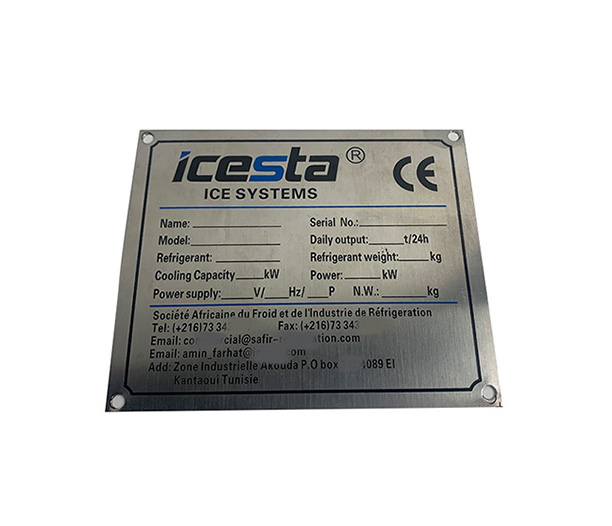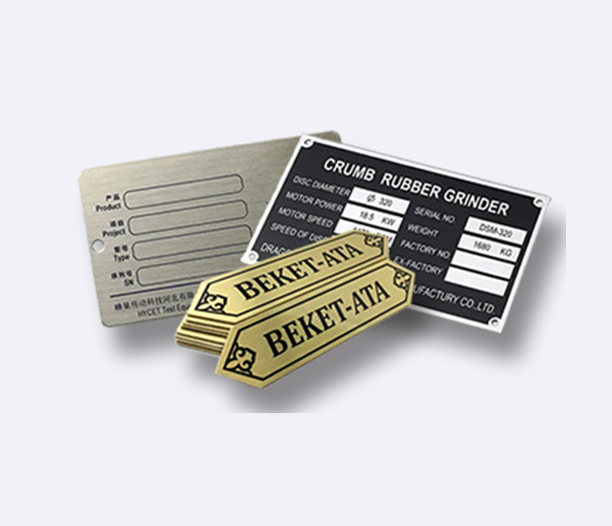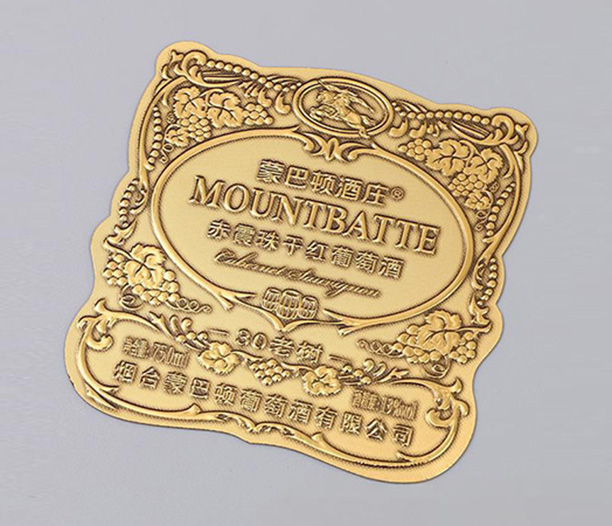Hey there! Ever stop to really look at that sturdy, informative plate on your laptop, industrial machine, or even your favorite power tool? Chances are, it’s made of aluminum. Aluminum Nameplates are everywhere – they’re the unsung heroes of product identification, branding, and safety information. But have you ever wondered how they’re made? It’s not just about stamping some letters onto metal. There’s some fascinating science and engineering behind creating these durable, good-looking tags. Let’s peel back the layers and dive into the manufacturing magic of Aluminum Nameplates.

Why Aluminum Reigns Supreme for Nameplates
First off, why is aluminum the go-to material? It’s not just about being lightweight (though that helps!). It boils down to a killer combo of properties:
- Corrosion Resistance: Aluminum naturally forms a thin, protective oxide layer when exposed to air. This layer is super tough and prevents rust – crucial for items used outdoors, in harsh factories, or even just in your garage. This inherent resistance is the starting point for making long-lasting Aluminum Nameplates.
- Strength-to-Weight Ratio: Pound for pound, aluminum is surprisingly strong. It can withstand bumps, vibrations, and general wear-and-tear without adding bulk or weight to the product it’s attached to.
- Machinability and Formability: Aluminum is relatively soft and easy to work with. Manufacturers can cut, stamp, bend, and shape it precisely into countless sizes and forms needed for specific applications.
- Superior Surface for Finishing: That smooth aluminum surface is like a perfect canvas. It readily accepts a wide range of finishes – painting, printing, etching, anodizing – giving designers tons of flexibility for look and durability. This versatility is key to creating functional and attractive Aluminum Nameplates.
- Conductivity & Non-Magnetic: While not always critical, these properties are essential for electronics and sensitive equipment where magnetic interference or static buildup is a concern.
- Recyclability: It’s 100% recyclable without losing quality, making it an environmentally conscious choice – a big plus these days.
The Manufacturing Journey: From Blank Sheet to Finished Plate
Creating Aluminum Nameplates is a multi-step process, blending material science with precise engineering. Here’s the typical flow:
- Material Selection & Preparation:It starts with high-quality aluminum alloy sheets or coils. Common alloys include 5052 and 6061, chosen for their excellent balance of strength, formability, and corrosion resistance.The raw aluminum surface needs prep. This usually involves thorough cleaning (degreasing) and often a light chemical etch or mechanical abrasion (like brushing or blasting) to create a microscopically rough surface. Why? This increases the surface area and provides better "tooth" for paints, inks, or adhesives to bond securely – a critical step for longevity.
- The Marking Process: Where Art Meets ScienceThis is where the information gets applied. Several high-tech methods are used, each with its own science:Screen Printing: A classic method. Ink is forced through a fine mesh screen (with a stencil blocking areas) onto the aluminum. Science bit: The ink formulation is crucial – it must adhere well to the prepared aluminum surface and withstand the curing process (heat or UV light) that polymerizes it, creating a tough, chemical-resistant layer. Perfect for bold graphics and logos on Aluminum Nameplates.Photo Anodizing / Chemical Etching: This is a subtractive process. A light-sensitive resist is applied to the aluminum. It's exposed to UV light through a film negative (like old-school photography), hardening the resist where light hits. The unhardened resist is washed away. Then, the plate is submerged in an etching chemical (like an acid or alkali solution) which dissolves the exposed aluminum, creating recessed lettering or graphics. Science bit: Precise control of etchant concentration, temperature, and time is vital to achieve clean, sharp features without undercutting. Great for permanent, tamper-proof markings.Digital Printing (UV Inkjet): The new kid on the block. High-resolution inkjet printers deposit UV-curable inks directly onto the aluminum. Science bit: The inks contain photoinitiators. When hit with intense UV light immediately after printing, they undergo a rapid polymerization reaction, instantly hardening into a durable, weather-resistant layer. Offers incredible detail and color flexibility for complex Aluminum Nameplates.Embossing/Debossing: Using powerful presses and hardened dies, the aluminum sheet is physically deformed to raise (emboss) or lower (deboss) lettering or borders. Science bit: This leverages aluminum's ductility. Precise control of pressure and die design ensures clean definition without cracking or excessive thinning of the metal. Creates a classic, tactile feel.
- The Power of Anodizing: Building Armor (Optional but Common)Anodizing is an electrochemical process that thickens aluminum’s natural oxide layer, transforming the surface. It’s incredibly common for Aluminum Nameplates needing maximum durability and a premium look. Here’s the science:The aluminum plate is immersed in an acidic electrolyte bath (usually sulfuric acid) and becomes the anode (hence "anodizing") in an electrical circuit.Applying electrical current causes oxygen ions from the solution to react with the aluminum surface.This reaction builds a controlled, porous, crystalline layer of aluminum oxide integral to the metal itself – it’s not just a coating sitting on top. This layer is:Extremely Hard: Harder than tool steel, making it incredibly scratch and abrasion-resistant.Super Corrosion Resistant: A much thicker, more effective barrier.Porous: This is key! The pores allow for...Coloring: Dyes can be absorbed into the pores before sealing. Alternatively, integral color anodizing uses specific alloys and electrolytes to create bronze or black finishes directly within the oxide structure (more fade-resistant).Sealing: Finally, the plate is immersed in hot water or a sealing solution. This hydrates the oxide layer, causing the pores to swell and close shut, locking in dye (if used) and maximizing corrosion resistance. Anodized Aluminum Nameplates are built to last decades.
- Protective Coatings & Laminates:Sometimes an extra layer of defense is needed:Clear Coatings: A transparent polymer layer (like polyester or polyurethane) can be applied over printed graphics for added UV protection and abrasion resistance.Polymer Overlays: A thin, durable plastic film (often polycarbonate) is laminated over the entire plate. This provides exceptional chemical resistance, scratch protection, and allows for the addition of transparent windows or textured areas. Common on control panels and industrial Aluminum Nameplates.
- Cutting to Shape & Secondary Operations:The printed/anodized sheets are cut into individual nameplates using precision dies, CNC routers, or laser cutters. Lasers are particularly cool – they use focused light energy to vaporize metal with incredible precision and clean edges.Secondary steps might include bending tabs, adding holes for rivets or screws, or applying pressure-sensitive adhesive (PSA) backing. The science of PSA involves carefully formulated acrylic adhesives designed to bond strongly to both the aluminum and the target surface, often with specific properties for high or low temperatures.

Why the Science Matters: The End-User Benefits
All this manufacturing science translates directly into why Aluminum Nameplates are the preferred choice for demanding applications:
- Unmatched Durability: Resists fading (UV), scratching, chemicals, solvents, extreme temperatures, and corrosion. They simply don’t break down like plastic or paper labels.
- Legibility for Life: The marking methods (especially etching and anodizing) create information that’s integral to the plate, not just sitting on top. Safety warnings, serial numbers, and certifications must remain readable for the entire product lifespan.
- Professional Aesthetics: Offers a premium, metallic look that enhances brand perception. Anodizing provides beautiful, consistent colors and sheens.
- Versatility: Can be made rigid or flexible, tiny or large, simple or incredibly complex. Adapts to almost any product need.
- Tamper-Evidence: Etched or embossed markings are extremely difficult to alter or remove without obvious damage, crucial for security and authenticity.
- Regulatory Compliance: Meets stringent requirements for safety labels, machinery identification, and certification markings across industries (UL, CSA, MIL-STD, etc.).
Where You'll Find Aluminum Nameplates Shining
The next time you're around equipment or products, look for these workhorses:
- Industrial Machinery & Controls: Serial plates, data plates, control panel overlays, warning labels.
- Aerospace & Defense: Equipment ID, part numbers, safety warnings, maintenance instructions (must withstand extreme environments).
- Medical Devices: Sterilization-resistant labels, instrument identification, compliance markings.
- Electronics & IT: Laptop bottoms, server IDs, network equipment labels, certification badges (UL, CE, FCC).
- Automotive & Marine: VIN plates, engine components, under-hood labels, marine instrumentation (salt spray resistance!).
- Consumer Goods & Appliances: Model/serial numbers, rating plates, branding badges.
- Outdoor Equipment: Power tools, generators, HVAC units – anywhere weather resistance is key.
The Bottom Line: Precision Engineering for Lasting Impact
So, the next time you glance at an Aluminum Nameplate, remember it’s not just a simple tag. It’s the product of sophisticated material science, precise chemical and electrochemical processes, advanced printing technologies, and meticulous engineering. From leveraging aluminum's natural properties to building armor through anodizing and applying information with cutting-edge techniques, the manufacturing of Aluminum Nameplates is a brilliant blend of chemistry, physics, and mechanical engineering. This science ensures these critical identification markers perform flawlessly – looking sharp and staying legible – year after year, in the toughest conditions imaginable. That’s the quiet power and enduring value of a well-made aluminum nameplate.






